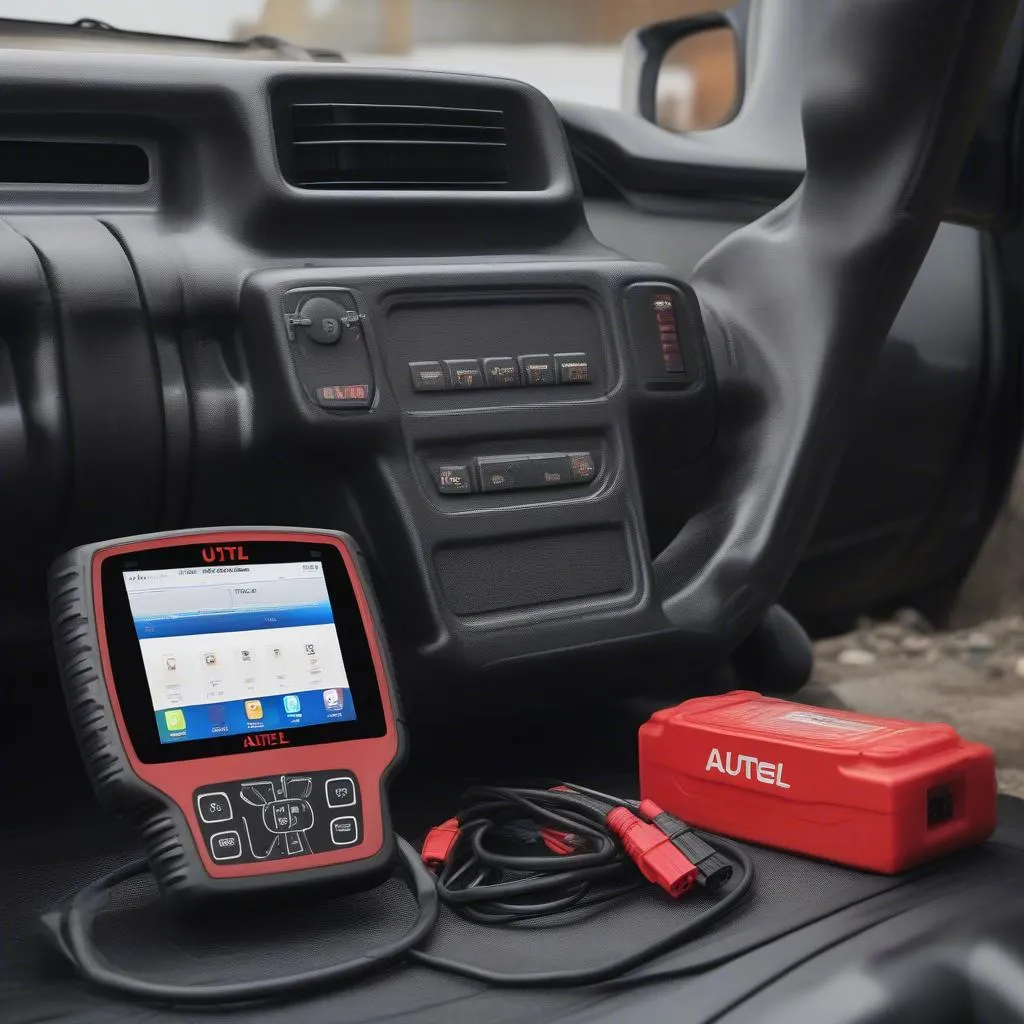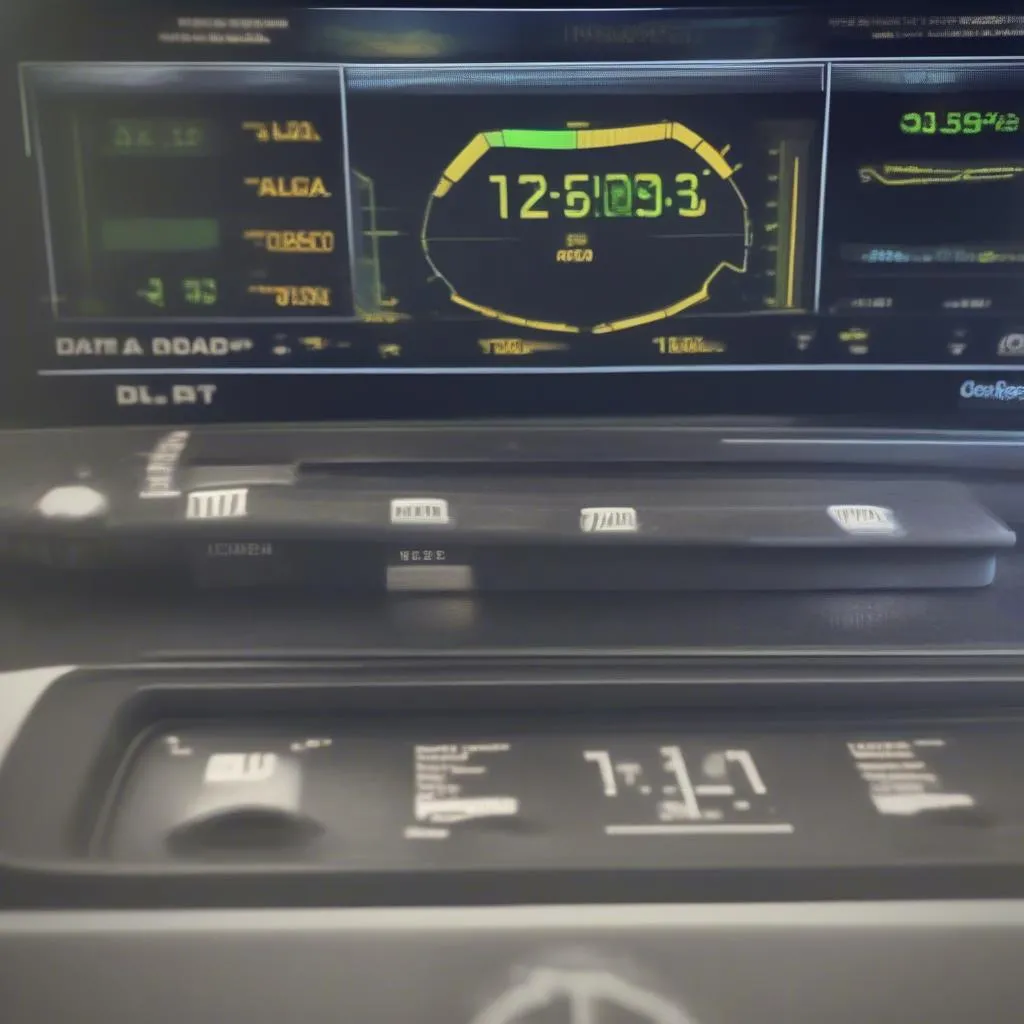Have you ever been in a situation where your diesel engine started acting up? You might hear strange noises, feel a loss of power, or notice a sudden decrease in fuel efficiency. These symptoms can be frustrating and expensive, especially if you don’t know where to start looking for a solution. But fear not, diesel enthusiasts! We’re here to equip you with the knowledge and tools to diagnose and fix those pesky diesel problems. Today we’ll dive into the world of Diesel Scanners, your trusty companion for navigating the complex inner workings of diesel engines.
What is a Diesel Scanner and Why Do You Need One?
Think of a diesel scanner as a mechanic’s stethoscope, but with a much broader range of abilities. It’s a powerful diagnostic tool that allows you to communicate with your diesel engine’s electronic control unit (ECU).
Imagine this: you’re driving your trusty Ford F-350 down the highway in rural Oklahoma, and suddenly, it loses power. Your heart sinks, and you’re left wondering what went wrong. Thankfully, you have your trusty diesel scanner at hand. With a few clicks, you can connect to the ECU and retrieve valuable information about the engine’s performance. The scanner might reveal a faulty fuel pressure sensor, a clogged fuel filter, or even a problem with the engine’s electronic control system. Armed with this knowledge, you can confidently tackle the repair and get back on the road in no time.
The Significance of Diesel Scanners: A Deeper Dive
From the perspective of a diesel mechanic, a scanner is a critical tool for providing a precise diagnosis and understanding the health of the engine. It’s a vital part of the modern mechanic’s arsenal.
From a technical standpoint, diesel scanners allow you to:
- Read and clear diagnostic trouble codes (DTCs): These codes, like messages from the engine itself, can help you identify specific problems.
- Monitor live data streams: This real-time information allows you to see how different engine parameters are operating, such as fuel pressure, engine speed, and air flow.
- Perform actuator tests: This ensures that various components like injectors and turbochargers are working correctly.
- Reprogram ECU parameters: In some cases, you can use a diesel scanner to update the ECU with new software, improving performance or fixing bugs.
The economic benefits of using a diesel scanner are undeniable. By accurately diagnosing problems and fixing them efficiently, you can save money on unnecessary repairs and keep your diesel engine running smoothly for years to come.
Unraveling the Mystery of Diesel Scanners: FAQs
We know you might have a few questions buzzing around in your head. Let’s address some of the most common queries about diesel scanners.
What Types of Diesel Scanners Are Available?
There’s a whole world of diesel scanners out there, catering to various budgets and needs. You’ll find scanners that are specifically designed for certain brands or models, such as those compatible with Cummins, Detroit, and Mercedes-Benz, among others. There are also general-purpose diesel scanners that can work on a wider range of diesel engines.
Here are some of the most popular diesel scanner brands:
- Autel: Known for their wide range of scanners, including the Autel Maxisys MS908CV, which is a powerful option for professional mechanics.
- Launch: Offers a good selection of diesel scanners at various price points.
- Snap-on: A trusted brand in the automotive industry, known for their high-quality scanners.
- BlueDriver: Provides a user-friendly, Bluetooth-enabled scanner that’s popular among DIY mechanics.
What Features Should I Look for in a Diesel Scanner?
The features you need in a diesel scanner depend on your specific requirements and how you plan to use it. Here are some key features to consider:
- Compatibility: Make sure the scanner is compatible with your diesel engine’s make and model.
- Functionality: Consider the range of functions offered, such as reading codes, monitoring live data, and performing actuator tests.
- Interface: Look for a user-friendly interface that’s easy to navigate.
- Connectivity: Choose a scanner with a reliable connection to your vehicle, whether it’s via Bluetooth, Wi-Fi, or a wired connection.
- Software Updates: Make sure the manufacturer provides regular software updates to ensure compatibility with the latest vehicle models and keep the scanner up-to-date.
How Do I Choose the Right Diesel Scanner for My Needs?
Choosing the right diesel scanner depends on your individual requirements, budget, and level of experience.
- Do you need a scanner for professional use or for DIY repairs?
- What specific features are most important to you?
- What is your budget?
If you’re a professional mechanic, you’ll likely want a powerful scanner with a wide range of capabilities and features.
If you’re a DIY mechanic, a more affordable scanner with user-friendly features might be a better fit.
Are Diesel Scanners Difficult to Use?
Many diesel scanners are designed to be user-friendly, with intuitive interfaces and clear instructions. However, some more advanced models can be a bit more complex.
If you’re new to diesel scanners, it’s always a good idea to start with a beginner-friendly model or seek guidance from a qualified professional. You can find numerous online resources and tutorials to help you get started.
Where Can I Find a Diesel Scanner?
Diesel scanners can be purchased from various sources, including:
- Online retailers: Amazon, eBay, and other online marketplaces offer a wide selection of diesel scanners.
- Automotive supply stores: AutoZone, Advance Auto Parts, and other automotive supply stores carry a range of diesel scanners.
- Specialized automotive tools dealers: These retailers offer a broader selection of advanced diesel scanners and tools.
Can I Use a Diesel Scanner to Tune My Engine?
While some diesel scanners allow you to adjust certain parameters, you should exercise caution when making changes to your engine’s ECU.
Tuning your engine without the proper expertise can lead to serious damage and void your warranty.
Always consult with a qualified mechanic or tuner before making any changes to your engine’s ECU.
Using a Diesel Scanner: A Step-by-Step Guide
Now that you have your diesel scanner, you’re ready to start diagnosing problems and ensuring your diesel engine’s health.
Connecting the Scanner
- Locate the OBD-II port: This port is typically located under the dashboard, near the steering column.
- Connect the scanner: Connect the scanner to the OBD-II port, either via Bluetooth, Wi-Fi, or a wired connection.
- Power on the scanner: Turn on the scanner and wait for it to establish a connection with the vehicle’s ECU.
Reading Diagnostic Trouble Codes (DTCs)
- Select the “Code Reader” function: This function allows you to read any error codes stored in the ECU.
- View the DTCs: The scanner will display the DTCs, which can be deciphered using a lookup table or a reliable online resource.
- Clear the DTCs: After addressing the underlying problem, you can clear the DTCs from the ECU.
Monitoring Live Data
- Select the “Live Data” function: This function allows you to view real-time information about engine parameters.
- Select the parameters to monitor: Choose the parameters you want to monitor, such as engine speed, fuel pressure, and air flow.
- Analyze the data: Compare the live data readings to the manufacturer’s specifications to identify any potential problems.
Performing Actuator Tests
- Select the “Actuator Tests” function: This function allows you to test various components like injectors, turbochargers, and solenoids.
- Select the component to test: Choose the specific component you want to test.
- Follow the instructions: The scanner will provide instructions on how to perform the test.
Troubleshooting Common Diesel Engine Problems
Diesel scanners are powerful tools that can help you troubleshoot a wide range of common diesel engine problems, such as:
- Engine misfires: If you’re experiencing engine misfires, a diesel scanner can help you identify the faulty cylinder or injector.
- Reduced power: A diesel scanner can help you diagnose problems that might be causing a loss of power, such as a clogged fuel filter or a faulty turbocharger.
- Increased fuel consumption: If you’re noticing an increase in fuel consumption, a diesel scanner can help you identify any problems with the fuel system, such as a leaking injector or a faulty fuel pressure sensor.
- Smoke from the exhaust: A diesel scanner can help you identify the source of the smoke, such as a faulty injector, a clogged DPF (Diesel Particulate Filter), or a problem with the EGR (Exhaust Gas Recirculation) system.
Conclusion
Diesel scanners are valuable tools that can help you diagnose and troubleshoot a wide range of problems with your diesel engine. With the right scanner, you can get to the root of any engine trouble and ensure that your diesel vehicle is running smoothly and efficiently. Remember, always refer to your vehicle’s owner’s manual or consult with a qualified mechanic for specific guidance and troubleshooting tips.
Have any other questions about diesel scanners? We encourage you to leave a comment below and share your experiences. We’re always here to help you navigate the world of diesel diagnostics and keep your engine running strong.
Don’t forget, we’re just a WhatsApp message away! Contact us at +84767531508 for expert advice and support with setting up your diagnostics tool. Our team of skilled mechanics is available 24/7 to assist you.
 diesel scanner obd2
diesel scanner obd2
 autel diesel scanner
autel diesel scanner
 diesel scanner interface
diesel scanner interface